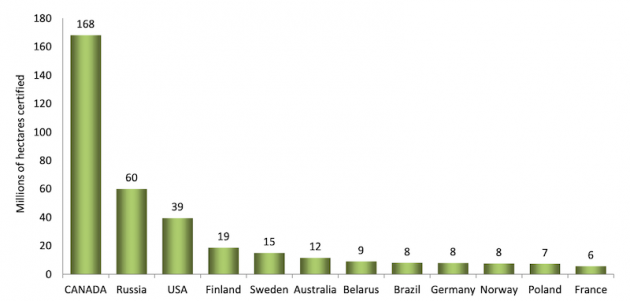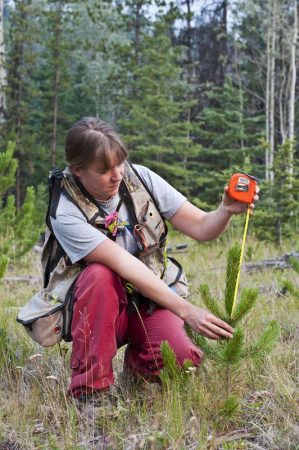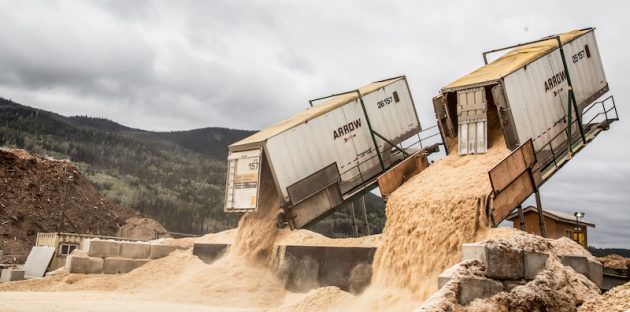
Canada’s wood pellet industry: leading the way in certified fibre
July 29, 2020
By The Wood Pellet Association of Canada
 Figure 3. A forest professional measures growth of a young lodgepole pine tree in Central British Columbia. Photos courtesy WPAC.
Figure 3. A forest professional measures growth of a young lodgepole pine tree in Central British Columbia. Photos courtesy WPAC. Canada is a leading supplier of wood pellets from certified sustainable and legal sources. Today, electric power stations in Europe and Asia are using Canadian wood pellets to displace coal and reduce fossil greenhouse gas (GHG) emissions. For example, Drax Power operates the world’s largest biomass power station providing about six percent of the UK’s electricity supply. Drax was a former coal power station that converted to wood pellets, thereby reducing its GHG emissions by more than eighty percent. Many of these wood pellets are imported from Canada.
Global customers are committed to sustainability throughout their supply chains and ensuring the legality and sustainability of their biomass supply is critical to their business models. Canada’s wood pellet industry plays a large part in helping customers meet their commitments with a growing supply of pellets produced entirely from the residuals of sustainably managed forests. Canada’s forests are highly regulated to comply with some of the most stringent regulations in the world, and those regulations are enforced by government and backed by independent certification.
Independent assurance of sustainable sources
Canadian pellet producers typically do not directly manage forests. Instead, producers buy fibre as a direct by-product of the lumber industry, or through the purposeful extraction of dead, diseased or damaged or low-quality trees by independent logging contractors. Canadian pellet producers ensure the sustainability of their fibre purchases by dealing exclusively with reputable suppliers and knowing where the suppliers’ timber supplies comes from.
This is backed up by internationally recognized third-party forest management certifications. The Forest Stewardship Council (FSC) has a national standard for Canada. The Programme for the Endorsement of Forest Certification (PEFC) endorses two Canadian forest management certifications: Canadian Standards Association (CSA) and Sustainable Forest Initiative (SFI). These certification programs share the common goals of providing third party assurance of sustainable forest management.
The forest management certifications are supplemented by third-party certification of chain-of-custody to the standards of FSC, PEFC or SFI. Chain of custody certifications proves that sustainability is maintained as fibre changes hands along the supply chain from the forest to the end customer.
All forest certification programs used in Canada promote principles, criteria and objectives that are viewed around the world as the basis of sustainable forest management. Each has balanced governance, with boards representing environmental, social and economic interests and all revise their standards regularly through an open public process.
They also evaluate for basic forest stewardship by ensuring that harvested areas are reforested, that laws are obeyed and that there is no unauthorized or illegal logging. They also ensure biological diversity is conserved, timber is harvested sustainably, and wildlife habitat, soils and water resources are conserved.
Certifications are carried out by independent, internationally recognized certification bodies that annually assess forestry operations against standards for sustainable forest management. This, coupled with strong forest management laws, supports Canada’s reputation as a source of legally and sustainably produced forest products. When it comes to forest certification, Canada leads the world with an estimated 164 million hectares certified.

Figure 2. Canadian Forest Certification in the Global Context – 2019. Source
Sustainable Biomass Program: additional assurance
Canadian wood pellet producers who export to Europe and Asia are third-party certified to the standards of the Sustainable Biomass Program (SBP). SBP was set up in 2013 to provide assurance that woody biomass – mainly wood pellets and wood chips used for large-scale energy production – is sourced from legal and sustainable sources. But rather than replacing established forest certification programs, SBP recognizes FSC and PEFC standards, including those endorsed by PEFC, such as SFI and CSA forest management standards, and chain-of-custody certified fibre through FSC, PEFC and SFI.
While the vast majority of fibre from Canada comes from certified forests, any uncertified fibre must be evaluated against SBP criteria, and the wood pellet manufacturer must carry out a risk assessment to identify the risk of compliance against 38 SBP indicators covering 16 criteria for legality and sustainability:
- The supply area from which fibre is sourced is properly defined.
- The forest owner or manager holds legal rights to the forest.
- Laws are being complied with.
- Royalties and taxes are being paid.
- The Convention on International Trade in Endangered Species of Wild Fauna and Flora is being complied with.
- Harvesting does not violate traditional or civil rights.
- Protection of exceptional forest values and species
- Protection of ecosystem functions
- Maintaining forest productivity
- Protecting ecosystem health and vitality
- Respecting legal and traditional rights of indigenous peoples and communities
- Resolving grievances and disputes
- Safeguarding labour rights of forest workers
- Protecting health and safety of forest workers
- Maintaining carbon stocks
- Prohibiting use of genetically modified trees
While FSC, SFI and CSA do not include requirements for reporting energy data, SBP fills this gap by creating a framework for suppliers to report third-party verified energy data associated with biomass production and transportation to the generators that purchase their pellets enabling them to calculate GHG emissions savings.
Like the three forest management certification programs, SBP incorporates the use of external audits and third-party certification by independently accredited certification bodies.

Figure 3. A forest professional measures growth of a young lodgepole pine tree in Central British Columbia. Photos courtesy WPAC.
Global supplier of sustainable fibre
Canada is recognized as a global leader in sustainable forest management. Canada’s framework of stringent forest laws, public involvement, skilled forestry professionals, and comprehensive monitoring, compliance and enforcement provides a solid foundation for sustainability. Third party certification builds on that foundation to solidify Canada’s global reputation as a source of sustainable forest products. That’s why today, Canada’s wood pellet industry is a global supplier that international customers can rely on for a stable supply of high-quality pellets from legal and sustainable sources.
Print this page
